Step back in time with me for a minute, to 1996.
Remember when?
Former President Bill Clinton appointed Madeleine Albright as first female US Secretary of State. A 747 crashed off Long Island. And everybody was doing the Macarena (admit it, I know you were 😉).
On the business front, Steve Jobs had returned to Apple, first as an advisor, then as interim CEO.
One of the first things he did? Refine the product strategy – beginning with the desktop computer portfolio.
3 Key Elements Redefine Apple’s Product Strategy
Jobs had been absent for about ten years from the company he co-founded, and he saw far too much complexity in how products were being developed and marketed. He wanted to bring three key elements to the product strategy:
- Focus
- Simplicity
- Discipline
During one meeting, Jobs drew four simple boxes on a flipchart. Atop the two columns, he wrote “Consumer” and “Pro.” He labeled the two rows “Desktop” and “Portable.” The objective was straightforward: to make four great products – one for each quadrant (see figure 1).
Simplicity + Strategic Focus = Success
This level of simplicity and focus is exactly what Apple needed then to deliver really strong products with specific targets in mind. Today, Apple’s product strategy is obviously more sophisticated, yet it continues to be defined by a clear, thoughtful approach to where-to-play decision making.
It’s worth mentioning where Apple decided not to focus. The company has primarily stayed within the realm of hardware, software, and consumer products and services. Although they serve business-to-business customers, they leave much of that to Dell, HP, Lenovo, and other companies.
By comparison, another prominent company – Southwest Airlines – stays close to its core. Southwest focuses on low-cost airfare among business and vacation flyers, growing mainly by adding routes (organically and through acquisition).
Yes, they’ve added credit cards and also do a healthy business in freight, but mostly they’re an airline serving airline customers. At the end of every day, Southwest offers a similar, relatively basic service experience to all its customers.
Starbucks Focuses on Its Coffee & Retail Heritage
 Starbucks maintains a fairly tight focus on its coffee and retail heritage. The company has moved beyond morning coffee to a variety of beverage types (including tea and bottled drinks) and food items (bistro boxes, sandwiches, paninis, and salads).
Starbucks maintains a fairly tight focus on its coffee and retail heritage. The company has moved beyond morning coffee to a variety of beverage types (including tea and bottled drinks) and food items (bistro boxes, sandwiches, paninis, and salads).
Plus, they’ve redesigned their in-store experience and invaded grocery stores and other outlets, all so you can enjoy your favorite latte while running errands.
More recently, the company made other changes, reallocating investments and selling off one of its tea brands. They’ve introduced a 15,000-square-foot Starbucks Reserve Roastery and Tasting Room to promote its rarest, small-batch coffees. Starbucks Reserve targets the most involved coffee connoisseur…still in alignment with Starbucks’ renewed commitment to its rich coffee heritage.
The Power of a To Whom, For What Mindset
Each of these highly successful companies explicitly decides:
- to whom its offerings should be targeted, and
- for what particular need area
This to-whom, for-what mindset helps define the playing field. Some of the profiled companies have a tight view of their market space; others take an expansive view. Which approach is best? In reality, either can be successful.
What they all share in common is an intentionally defined strategy to approach specific customer segments with particular products…and not to pursue certain interests. This allows them to concentrate their resources on the areas they have defined as most promising.
Would you like to gain deeper insight into developing a marketing strategy based on the successful work here at Equibrand? We’re pleased to offer you a complimentary download of the third chapter of our best-selling book, Upstream Marketing. Get quick access here.





















Follow EquiBrand